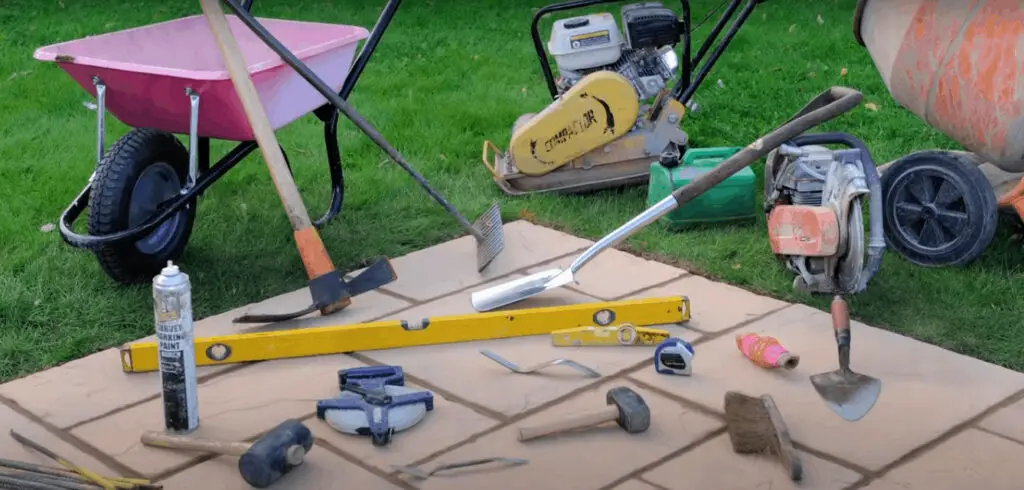
Excavating dirt to build a patio is not an easy task. Excavation and soil removal can be hard work, but it’s worth it when you see the final product!
This article walks through the process of how to excavate for your perfect patio and walkway project.
We cover everything from what equipment you need, where to find and buy materials, tips on excavation safety as well as advice on dealing with hidden surprises like utilities or old tree roots.
If this sounds overwhelming there are also some links at the end of this post that will help get you started in finding contractors who specialize in these types of projects.
So if you have been considering adding a patio or walkway into your backyard landscape design then read on – we hope our guide helps make the process less daunting and inspires you to take the leap!
Read More: Cover Brick Patio With Cement + Cost Calculator
Best Way To Excavate Dirt For a Patio or Walk
The best way to excavate dirt for a patio depends on the size of your project and what you plan on using it for.
For example, if you just want to take out about three cubic yards of earth (enough to cover an average-sized room), then hand digging is the cheapest option.
If you need more than that – say, six or seven cubic yards – renting a backhoe may be worth considering.
The cost difference per yard is relatively negligible with this scale of excavation task; in fact, depending on where you live, hiring a professional could actually set you back less money overall because they will charge by the hour rather than by volume moved as most equipment rental companies do.
This also means that if there are any unexpected obstacles underground like a sprinkler line, you’ll be charged for the time it takes to deal with them.
Tools
| Round-nose shovel | Marking paint |
| Spade | Sand |
| Small sledgehammer | Garden hose |
| Mason’s line | Level |
| Wheelbarrow | Tape measure |
| Chalk line | Stakes |

Steps To Excavate Dirt For a Patio or Walk
Excavating dirt is a dirty job, but someone has to do it. This article will provide you with the basics on how to excavate dirt for your patio or walkway.
It’s not as hard as you may think and can be done in just a few hour’s time. So grab your shovel and let’s get started
1. Permission
The first step before digging up dirt is making sure that you have permission from all property owners involved as well as figuring out where new utility lines might be underground so they don’t get cut during excavation work (a dangerous situation).
It’s also important to know what surrounding structures could affect how deep the hole needs to be dug; if its next-door neighbor has a pond right behind its house, that will need to be accounted for.

2. Mark Layout
Mark one corner of the patio with stakes and string. Connect the corners with lines in order to mark a rectangle that is at least 20 inches wider than your desired finished size for the excavation area.
The height should also be no more than 12 inches above ground level.
This will help you excavate dirt evenly around all four sides without spilling over onto the lawn or sidewalk outside your property line, which could lead to fines from local ordinances governing landscaping.
TIP: Caliper -You can use this tool when digging up the soil so that each hole has an equal depth while maintaining a uniform width throughout; it’s like having a ruler on hand as you measure out where to dig next!

3. Dig Trench
The trench is dug in a zig-zag pattern to avoid creating an area that will be difficult or impossible to fill later.
Typically, the first row of trenches is laid out four feet apart and placed two yards from the house foundation so there won’t be any obstacles when it’s time for backfill.
Trenches should also be at least one foot deep but no more than two feet deep as this can result in settling problems during heavy rainfalls.
The width of each trench ideally ranges between three and five feet wide with four being the most common option.
In addition, you’ll want to make sure they’re all about six inches longer than your planned depth because dirt often settles after excavation work has been completed.

4. Check Trench Regularly
The depth of the trench should be periodically measured using a tape measure for consistency. (so, that way it will remain constant and you’ll have a reference point if you excavate the interior of the site)

5. Excavating
The next step in this process is to excavate the interior and exterior lines. Once again, use a garden spade to remove dirt from within the sketched area of your patio.
For best results, do not dig too deeply past the surface level; just enough so that you can easily create even sides for your new concrete slab.
The soil on top should be tamped down thoroughly but loosely with a tamper or rake after it has been removed so as not to damage surrounding grasses or plants: they will grow back!
How deep do you need to excavate for a patio?
Excavating soil for patios or walkways can vary depending on personal preference and local conditions.
The general recommendation is between 10 to 12 inches, but the right depth also depends on soil composition.
How deep should a patio stone be?
The depth of the dig depends on the patio type you are installing: 8 to 9 inches for a sand-and-gravel base, 8 to 9 inches for concrete slabs, and 11 to 12 inches if you are using bricks or stones instead of mortar.
How deep should a concrete patio be?
A concrete patio should be at least four inches thick, depending on the weight it needs to support. Six-eight inches of concrete is standard for a foundation with the minimum thickness recommended for all patios.
How deep to dig for patio pavers?
There are no set rules for how deep to dig, however, you should stay between 4 and 12 inches from the surface depending on your need.
Clay-based soil should not be excavated below three feet because it can break down and become unstable.
Conclusion
Dirt is a major part of any construction project. Whether you are working on an addition, remodeling the basement, or just doing some landscaping in your backyard, there will come a time when removing dirt and debris becomes necessary.
I hope this guide helped you with methods to excavate for different types of projects without hiring expensive professionals who charge by the hour.

![What Gravel To Use For Patio Base [Best Options]](https://www.cleverpatio.com/wp-content/uploads/2021/11/What-Gravel-To-Use-For-Patio-Base-270x180.jpg)


Leave a Reply